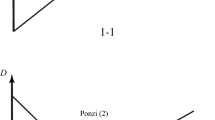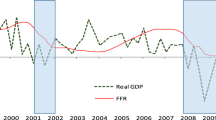Abstract
The financial cycle can play a decisive role in the transmission of monetary policy decisions. The impact of these decisions is amplified when the financial cycle is booming, and it is compressed when this cycle is busting. Considering this amplifier/divider mechanism in a semi-structural NKM, estimated for the US economy using Bayesian techniques, confirms this conclusion and improves the decision of raising or lowering the interest rate.





Similar content being viewed by others
Notes
Appendix 2 describes and presents the construction methodology of the composite financial index used in this work to describe the financial dynamics.
Expectations are model-consistent (Rational Expectations Hypothesis), and they are calculated using an ordered QZ (generalized Schur) decomposition.
Appendix 1 describes the data used.
All shocks are positives and simulate a 1 percentage point (ppt) increase of the variable.
In this model, the Eqs. (10), (11) and (12) are removed and the Eq. (4) is written without financial cycle. For the remaining parameters, their values are calibrated to be equal to the initial model posteriors. The objective is to illustrate the role of including the financial dynamics and the amplifier/divider mechanism. Without this calibration constraint, the parameters values will change.
In both scenarios, the output gap decreases by 1 ppt and the financial cycle increase/decrease by 0.1 ppt.
References
Aikman D, Haldane AG, Nelson BD (2015) Curbing the credit cycle. Econ J 125(585):1072–1109
Bernanke BS (1983) Non-monetary effects of the financial crisis in the propagation of the great depression
Bernanke B, Gertler M (1989). The Corporate Bond Credit Spread Puzzle
Bernanke BS, Gertler M (1995) Inside the black box: the credit channel of monetary policy transmission. J Econ Perspect 9(4):27–48
Bernanke BS, Gertler M, Gilchrist S (1999) The financial accelerator in a quantitative business cycle framework. Handb Macroecon 1:1341–1393
BIS (2016) Annual Report, no. 86. Bank for International Settlements, Basel
Borio C (2014) The financial cycle and macroeconomics: what have we learnt? J Bank Financ 45:182–198
Borio CE, Lowe PW (2002) Asset prices, financial and monetary stability: exploring the nexus
Borio C, Furfine C, Lowe P (2001) Procyclicality of the financial system and financial stability: issues and policy options. BIS papers, 1 (March), 1–57
Claessens S, Kose MA, Terrones ME (2011, May). Financial cycles: what? How? When?. In: International Seminar on Macroeconomics (Vol. 7, no. 1, pp. 303–344). Chicago: University of Chicago Press
Dieppe A, Georgiadis G, Ricci M, Van Robays I, Van Roye B (2017) ECB-Global: Introducing the ECB's global macroeconomic model for spillover analysis (no. 2045). ECB
Duprey T, Klaus B, Peltonen T (2017) Dating systemic financial stress episodes in the EU countries. J Financ Stab 32:30–56
Fisher I (1933) The debt-deflation theory of great depressions. Econometrica: J Econometric Soc 1:337–357
Hollo D, Kremer M, Lo Duca M (2012) CISS-a composite indicator of systemic stress in the financial system, CISS - A Composite Indicator of Systemic Stress in the Financial System
Illing M, Liu Y (2006) Measuring financial stress in a developed country: an application to Canada. J Financ Stab 2(3):243–265
Islami M, Kurz-Kim JR (2014) A single composite financial stress indicator and its real impact in the euro area. Int J Finance Econ 19(3):204–211
Lall MS, Cardarelli MR, Elekdag S (2009) Financial stress, downturns, and recoveries (no. 9–100). International Monetary Fund
Ljung L (1999) System identification: theory for the user. Upper Saddle River, New Jersey: Prentice Hall
Mishkin FS (1978) The household balance sheet and the great depression. J Econ Hist 38(4):918–937
Nelson WR, & Perli R (2007) Selected indicators of financial stability. Risk Measurement and Systemic Risk 4:343–372
Osorio MC, Unsal DF, Pongsaparn MR (2011) A quantitative assessment of financial conditions in Asia (No. 11–170). International Monetary Fund
Reinhart CM, Rogoff KS (2009a) The aftermath of financial crises. Am Econ Rev 99(2):466–472
Reinhart CM, Rogoff KS (2009b) This time is different: eight centuries of financial folly. Princeton, New Jersey: Princeton university press
Author information
Authors and Affiliations
Corresponding author
Ethics declarations
Conflict of interest
None.
Additional information
Publisher’s note
Springer Nature remains neutral with regard to jurisdictional claims in published maps and institutional affiliations.
Appendices
Appendix 1 Used data
The model is estimated on quarterly data of the US economy over the period 1970–2018. The variables used are:
- 1.
Real GDP
Source: U.S. Bureau of Economic Analysis.
Unit: US Dollars.
Methodological Details: Chained 2012 prices and seasonally adjusted.
- 2.
Consumer Price index
Source: Organization for Economic Co-operation and Development.
Unit: Index (base year 2010).
Methodological Details: Global, seasonally adjusted.
- 3.
Unemployment rate
Source: U.S. Bureau of Labor Statistics.
Unit: Percentage.
Methodological Details: Quarterly average of the monthly national unemployment rate, seasonally adjusted.
- 4.
Nominal interest rate
Source: Organization for Economic Co-operation and Development.
Unit: Percentage.
Methodological details: 3-months interbank rates for the United States.
- 5.
Credit and loans granted by commercial banks
Source: Board of Governors of the Federal Reserve System (US).
Unit: US Dollars.
Methodological details: Seasonally adjusted level at the end of the quarter.
- 6.
Residential Property Prices Index
Source: Bank for International Settlements.
Unit: Index (base year 2010).
Methodological Details: Covers all types of existing housing throughout the country. The series is deflated by the CPI.
- 7.
Consumer confidence Index
Source: Organization for Economic Co-operation and Development.
Unit: Index (Amplitude adjusted, Long-term average = 100).
Methodological Details: Quarterly average of the monthly data.
Appendix 2: Composite Index of Financial Dynamics
In the absence of a variable allowing to describe the financial cycle in an aggregated way, several researchers have proposed composite indexes to describe in a synthetic way this cycle. The principle of these indices is globally the same (see for example Illing and Liu (2006), Lall et al. (2009), Osorio et al. (2011), Hollo et al. (2012), Islami and Kurz-Kim (2014), Duprey et al. (2017)). In terms of financial variables, these indices are often based on the volume of credit and the price of real estate. Information from the stock market, interbank or bond may also be included if it is considered determinative for a country.
In this paper, we calculate a composite financial index denoted FI (Financial Index) using three variables: the credit level, the real estate price index (REPI) and the consumer confidence index (CCI). As mentioned by Borio (2014), the combination between credit and real estate prices appears to be the most parsimonious way of describing the financial cycle and its link with the business cycle and financial crises. However, we think that that credit and leverage constraints are a result of the financial cycle dynamics which are mainly determined by the optimism and the pessimism of the agents. Consequently, this paper suggests capturing the financial dynamic through a composite indicator that considers also information about consumer confidence (Fig. 6).
The FI index is the average of the individual financial series divided by their respective standard deviations and re-scaled to ensure that all the individual components lie between 0 and 1. In practice, the construction of the FI index is done in 3 steps. By adopting the notation Xi,j with i for the series and j for the time, the construction of the index is done as follows:
- 1.
The indexed series are divided by their respective variances:
This transformation is done to avoid overweighting highly volatile variables. It can be interpreted as a weighting that is equal to the variance (see Illing and Liu (2006) and Nelson and Perli (2007)).
- 2.
To ensure that all individual observations are between 0 and 1, the minimum value of these observations is subtracted from each of them and the series obtained is divided by its maximum over the period:
Thus, each of the individual components of the index will show 0 for the quietest period and 1 for the most disturbed period. This re-scaling avoids the aggregation bias of the individual components into a single composite index without considering different individual scales.
- 3.
The sum of the individual components (with equal weight) is divided by the number of series included in the index, 2 in our case, so that the value of the FI index is between 0 and 1:
Appendix 3: Bayesian estimation results of model parameters for the US economy
Parameters | Prior | Low. Bound | Up. Bound | Distribution | Posteriors |
|---|---|---|---|---|---|
α | 0.700 | 0.200 | 0.900 | Beta | 0.233 |
β | 0.700 | 0.050 | 3.000 | 0.834 | |
φ 1 | 0.900 | 0.100 | 0.900 | 0.118 | |
φ 2 | 0.900 | 0.300 | 0.900 | 0.300 | |
φ 3 | 0.500 | 0.100 | 0.500 | 0.474 | |
φ 4 | 0.900 | 0.100 | 0.500 | 0.278 | |
θ | 0.500 | 0.010 | 0.900 | 0.811 | |
τ1 | 0.100 | 0.050 | 0.900 | 0.078 | |
τ2 | 0.100 | 0.050 | 0.900 | 0.377 | |
τ3 | 0.300 | 0.050 | 0.900 | 0.050 | |
τ4 | 0.300 | 0.050 | 0.900 | 0.458 | |
ρ1 | 0.100 | 0.100 | 0.800 | 0.620 | |
ρ2 | 0.500 | 0.300 | 0.900 | 0.300 | |
ρ3 | 0.600 | 0.300 | 0.900 | 0.658 | |
μ1 | 0.600 | 0.050 | 0.900 | 0.900 | |
μ 2 | 0.600 | 0.050 | 0.900 | 0.900 | |
f 1 | 0.900 | 0.010 | 0.900 | 0.900 | |
f 2 | 0.400 | 0.100 | 0.900 | 0.390 | |
f 3 | 0.800 | 0.300 | 0.900 | 0.900 | |
f 4 | 0.600 | 0.300 | 0.900 | 0.476 | |
SD (\( {\varepsilon}^{\overline{Y}} \)) | 0.300 | 0.005 | 3.000 | Inverse Gamma | 0.010 |
SD (εG) | 0.800 | 0.005 | 3.000 | 0.557 | |
SD (εy) | 0.010 | 0.005 | 3.000 | 0.034 | |
SD (επ) | 0.010 | 0.005 | 3.000 | 0.322 | |
SD (εu) | 0.100 | 0.005 | 3.000 | 0.023 | |
SD (\( {\varepsilon}^{\overline{U}} \)) | 0.200 | 0.005 | 3.000 | 0.010 | |
SD (\( {\varepsilon}^{g\overline{U}} \)) | 0.200 | 0.005 | 3.000 | 0.124 | |
SD (εrn) | 0.010 | 0.005 | 3.000 | 0.174 | |
SD (\( {\varepsilon}^{\pi^{target}} \)) | 0.100 | 0.005 | 3.000 | 0.096 | |
SD (\( {\varepsilon}^{rr^{neutral}} \)) | 0.200 | 0.005 | 3.000 | 0.203 | |
SD (\( {\varepsilon}^{\overline{FI}} \)) | 0.100 | 0.005 | 3.000 | 0.056 | |
SD (εfi) | 0.200 | 0.005 | 3.000 | 0.019 |
Rights and permissions
About this article
Cite this article
Chafik, O. The amplifier/divider mechanism of the financial cycle. Int Econ Econ Policy 17, 363–380 (2020). https://doi.org/10.1007/s10368-019-00448-z
Published:
Issue Date:
DOI: https://doi.org/10.1007/s10368-019-00448-z





